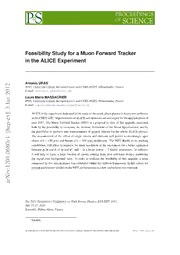Table Of ContentFeasibility Study for a Muon Forward Tracker
in the ALICE Experiment
Antonio URAS∗
2
1 IPNL,UniversitéClaudeBernardLyon-IandCNRS-IN2P3,Villeurbanne,France
0 E-mail: [email protected]
2
Laure Marie MASSACRIER
n
a IPNL,UniversitéClaudeBernardLyon-IandCNRS-IN2P3,Villeurbanne,France
J
E-mail: [email protected]
3
] ALICEistheexperimentdedicatedtothestudyofthequarkgluonplasmainheavy-ioncollisions
x
e attheCERNLHC.ImprovementsofALICEsub-detectorsareenvisagedfortheupgradeplansof
-
year 2017. The Muon Forward Tracker(MFT) is a proposal inview of this upgrade, motivated
p
e both by the possibility to overcome the intrinsic limitations of the Muon Spectrometer, and by
h
[ the possibility to perform new measurements of general interest for the whole ALICE physics.
The measurement of the offset of single muons and dimuons will permit to disentangle open
1
v charm (cτ ∼150 µm) and beauty (cτ ∼500 µm) production. The MFT, thanks to its tracking
0
capabilities, will allow to improve the mass resolution of the resonances for a better separation
8
6 betweenρ/ω andφ, J/ψ andψ(cid:48), and−toalesserextent−ϒfamilyresonances. Inaddition,
0
it will help to reject a large fraction of muons coming from pion and kaon decays, improving
.
1
the signal over background ratio. In order to evaluate the feasibility of this upgrade, a setup
0
2 composedbyfivesiliconplaneswassimulatedwithintheAliRootframework. Inthisreport,we
1
presentpreliminaryresultsontheMFTperformancesinalow-multiplicityenvironment.
:
v
i
X
r
a
The2011EurophysicsConferenceonHighEnergyPhysics,EPS-HEP2011,
July21-27,2011
Grenoble,Rhône-Alpes,France
∗Speaker.
(cid:13)c Copyrightownedbytheauthor(s)underthetermsoftheCreativeCommonsAttribution-NonCommercial-ShareAlikeLicence. http://pos.sissa.it/
FeasabilitystudyforaMuonForwardTrackerinALICE AntonioURAS
The ALICE experiment at the CERN LHC represents the most recent effort in the field of high-
energynuclearcollisions. IdentificationandmeasurementofmuonsinALICEareperformedinthe
MuonArm[1],coveringthepseudo-rapidityregion2.5<η <4. WithinthecurrentALICEmuon
physics program, currently active both in p–p and Pb–Pb collisions, three main directions can be
identified: study of quarkonia production[2], study of open Heavy Flavors (HF) production[3],
study of low mass dimuons[4]. This program currently suffers from various limitations, basically
becauseofthemultiplescatteringinducedonthemuontracksbythehadronabsorber,whichsmears
out the details of the vertex region. To overcome these limitations, the Muon Forward Tracker
(MFT)wasproposedinthecontextoftheALICEupgradeplansasasiliconpixeldetectoraddedin
theMuonSpectrometeracceptanceupstreamofthehadronabsorber. Theextrapolatedmuontracks,
coming from the tracking chambers after the absorber, are matched with the clusters measured
in the MFT planes before the absorber, gaining enough pointing accuracy to permit a reliable
measurementoftheiroffsetwithrespecttotheprimaryvertex.
TheMFTsetup, asdescribedinthesimulationstudiescurrentlybeingperformed, iscomposedof
fivetrackingplanesplacedatz=50,58,66,74,82cmfromthenominalinteractionpoint,before
the VZERO detector and the hadron absorber. Each plane is composed by a 0.2% x/X disk-
0
shaped support element, and by an assembly of silicon active and readout 50 µm-thick elements
arrangedinthefrontandbackpartofthesupport. FortheactiveelementscoveringtheMFTplanes
we assumed a 20×20 µm2 pixel segmentation, already available for a CMOS technology. The
tracking strategy starts from the muon tracks reconstructed after the hadron absorber: these are
extrapolated back to the vertex region, taking into account both the energy loss and the multiple
scatteringinducedbythehadronabsorber. Eachextrapolatedtrackisthenevaluatedatthelastplane
oftheMFT(theoneclosesttotheabsorber)and,foreachcompatiblecluster,anewcandidatetrack
iscreated,whoseparametersandtheiruncertaintiesareupdatedwiththeinformationgivenbythe
added cluster by means of a Kalman filter algorithm. Each candidate track is then extrapolated
back to the next MFT plane, where a search for compatible clusters is performed in the same
way as before. As the extrapolation proceeds towards the vertex region, the uncertainties on the
parametersoftheextrapolatedtracksbecomesmaller,thenumberofcompatibleclustersdecreases
andthenumberofcandidatetracksconverges.
√
With a spatial resolution of the order of ∼ 20 µm/ 12 in the MFT planes, we have a reliable
measurement of the muons’ offset, i.e. the transverse distance between the primary vertex and
the muon track. The observed offset resolution is ∼20 µm for muon momenta of ∼50 GeV/c,
staying as good as ∼100 µm even for muon momenta down to ∼7 GeV/c. Studies are ongoing
to better characterize the offset resolution as a function of the muon rapidity, too. Improved mass
resolutions are also observed thanks to the improved accuracy on the evaluation of the opening
angleforpromptmuonpairs. Acomparisonbetweenthecurrentlyavailableresolutionandtheone
resulting from the preliminary MFT simulations is shown in Figure 1, for the φ meson. With a
simple Gaussian fit on the peaks obtained with the MFT simulations, one finds σ ≈20 MeV/c2,
φ
animprovementuptoafactor∼3withrespecttotheresolutionsavailablewiththecurrentMuon
Armsetup. Finally,thedistributionoftheweightedoffsetofthedimuonshasbeenstudied,defined
2
FeasabilitystudyforaMuonForwardTrackerinALICE AntonioURAS
300
200
100
Figure 1: Comparison between the mass res-
olution available with the current Muon Arm
setup (red points and line) and the one achiev-
0
0.4 0.6 0.8 1 1.2 1.4 ablebymeansoftheMFT(blueprofile)forthe
Mass [GeV/c2] φ resonance.
as ∆ =(cid:2)0.5·(∆2 +∆2 )(cid:3)0.5, with ∆ =(cid:2)0.5·(δx2V−1+δy2V−1+2δxδyV−1)(cid:3)0.5, where δx
µµ µ1 µ2 µ xx yy xy
and δy are the x and y offset of the muon track, andV−1 is the inverse of the covariance matrix
accounting for the combined uncertainty on the track and the vertex position. Weighted offset
distributions for prompt, open charm and open beauty dimuons are superimposed in Figure 2,
wherethecomparisonshowshowareliableseparationbetweenthesignalcomponentsisfeasible,
onastatisticalbasis,withoutanymodeldependence.
Weighted Offset for Muon Pairs
102
10
Figure 2: Comparison between
the weighted dimuon distributions for
prompt (cyan profile), open charm (red
1
0 5 10 15 20 25 30 35 profile)andopenbeauty(greenprofile)
Weighted Offset dimuons.
In conclusion, the addition of a silicon Muon Forward Tracker in the acceptance of the Muon
Spectrometer should overcome the intrinsic limitations of the current ALICE muon physics. Pre-
liminaryresultsofthesimulationsincludingtheMFTareencouraging,andmotivateanadditional
effortaimingtoinvestigatethematchingperformancesinhighmultiplicity.
References
[1] K.Aamodt,etal.(ALICECollaboration),JINST3,S08002(2008)
[2] G.MartinezGarcia(ALICECollaboration)(2011),1106.5889
[3] A.Dainese(ALICECollaboration)(2011),1106.4042
[4] A.DeFalco(ALICECollaboration)(2011),1106.4140
3

